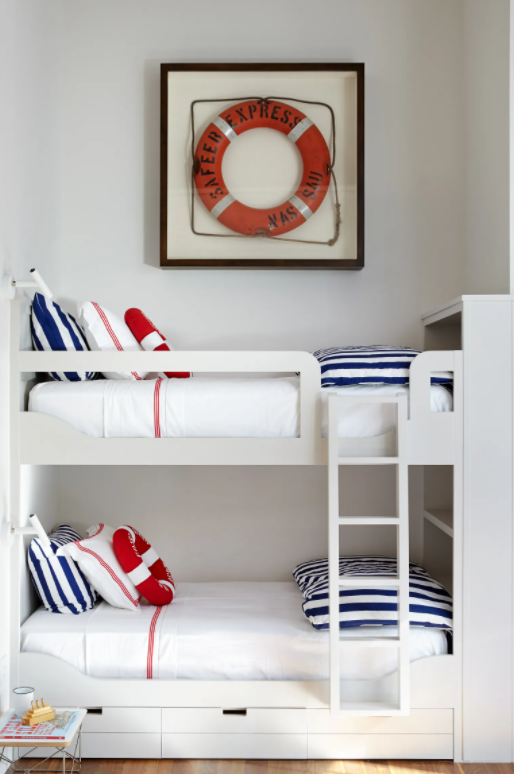7 Budget-Friendly Kids’ Room Design Ideas
With a bit of DIY savvy, you can avoid spending a fortune on your child’s constantly evolving bedroom.
Photo: Keith Scott Morton
From the kitchen to the primary suite, most rooms in your home are worth spending money on to create a space you love. When it comes to kids’ room design, on the other hand, you don’t necessarily have to invest serious cash. “The bedroom needs of a child change from year to year as they grow,” says interior designer Phillip Thomas of Phillip Thomas Inc. “What was an essential when they were babies becomes completely irrelevant when they’re four. The same goes for what they need in elementary school versus when they’re tweens.”
The bottom line, according to Thomas, is that if you don’t want to spend a lot of money decorating your constantly evolving child’s room, you can pull off a stylish aesthetic by following a few do-it-yourself hacks.
Below, Thomas and interior decorator Allison Babcock, of Allison Babcock Design, share their favorite DIY kids’ room design ideas and advice for how to approach the space.
Pick Your Theme Wisely
Babcock suggests choosing a theme that can grow with your child. “Children’s rooms don’t have to be overly juvenile to be joyful and age-appropriate spaces,” she says. A nautical theme, if you live in a coastal area, works for younger children as well as for older ones, with touches such as framed flags, black-and-white pictures of sailboats, and a buoy hanging on the wall as art. Fantasy themes are another idea because teenagers may appreciate them as much as toddlers. When decorating the room for a younger child, try peel-and-stick decals of woodlands and fairies. Older kids may like framed covers of popular fantasy books or sculptures of fantasy figures displayed on shelves.
Photo: Keith Scott Morton
Be Smart About Furniture
Invest in furniture that can change function as your children get older, says Babcock. Bunk beds that can convert into a pair of twin beds as siblings grow up is an example. “With slight rearrangements, a craft or play area for a younger child can be transformed into a lounge or study space for an older one, but you need to buy pieces that change as they do,” she says.
Thomas adds to her advice by suggesting that parents buy basic pieces of wood furniture from stores such as Crate & Barrel, Room & Board, and Pottery Barn Kids, which can be easily updated with a simple paint job. “Customizing the colors based on your child’s current age and tastes allows you to make the pieces more unique and personal,” he says. “This works really well to transform toy chests, desks, and beds.”
Make Art Personal
Skip expensive artwork. Thomas recommends buying a selection of picture frames (hit up One Kings Lane, Wayfair, and IKEA) to create a gallery wall. It’s easy to swap out the images in the frames as your child grows, from vintage children’s book illustrations to family photos. Babcock likes the idea of framing a few personal items, like outgrown baby shoes, clothes, or special toys. Or better yet, choose favorite pieces of your child’s own artwork to frame and hang.
Photo: Aydin Arjomand
Get Creative With the Walls
Why stick to basic painted walls when you can have fun playing with different design features instead? Thomas loves dry erase boards, which give your kids the freedom to redecorate every day depending on their mood, drawing polka dots, stripes, or simple landscapes. Peel-and-stick wallpaper is also a great option since it’s not permanent, and you can easily install it yourself. Babcock says that it allows you to completely change the feel of a room without an enormous mess or investment in both money and time.
Also, consider buying a simple stencil at a craft store or on Etsy. “You can transform a closet into a secret reading nook with a can of paint and a stencil, and if your child outgrows it, it’s easy to paint over again,” says Babcock.
Change Sheets and Accessories
Mixing and matching top and bottom sheets and pillowcases gives infinite options for color, pattern, and texture. Buy a few sets of inexpensive sheets from retailers such as Serena & Lily, Pottery Barn Kids, and One Kings Lane. Changing the bedding, throw pillows, and other small accessories as your child grows up is a wallet-friendly alternative to buying new furniture. “If your little girl wants a unicorn-themed room, let her have unicorn sheets and accents, which can be easily switched out for scalloped edge bedding and sports trophies when she gets older,” says Babcock.
Experiment With Lighting
Take a selection of inexpensive lighting fixtures and group them together to transform them into a larger and more unique piece. “Combining small lamps, mobiles, and toys into mini chandeliers…these pieces become a work of art in themselves,” says Thomas. “You can change the presentation to create new pieces for your kids as they get older.” For example, Thomas recently took four individual sailboat models that were nightlights and had each of them rewired to be mounted on a simple four-arm chandelier frame. The result added impact and personality to the room, he says.
Photo: Michael Mundy
Invest In Shelving
And finally, the one area that is worth investing in your kids’ room is the shelving, says Thomas, because if it has been well-designed it is timeless and can grow with your child. “They can tell stories about themselves through the trophies, books, and accessories they choose to display,” he says.
** This article was originally published by Shivani Vora on Architectural Digest. CLICK HERE to view the full article.



